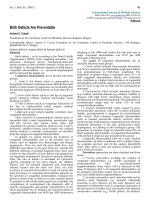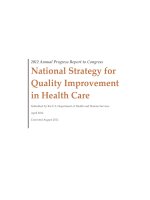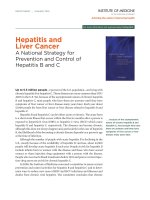Hepatitis and Liver Cancer: A National Strategy for Prevention and Control of Hepatitis B and C ppt
Bạn đang xem bản rút gọn của tài liệu. Xem và tải ngay bản đầy đủ của tài liệu tại đây (1013.22 KB, 191 trang )
Visit the
National Academies Press online, the authoritative source for all books
from the
National Academy of Sciences, the National Academy of Engineering,
the
Institute of Medicine, and the National Research Council:
• Download hundreds of free books in PDF
• Read thousands of books online for free
• Explore our innovative research tools – try the “Research Dashboard” now!
• Sign up to be notified when new books are published
• Purchase printed books and selected PDF files
Thank you for downloading this PDF. If you have comments, questions or
just want more information about the books published by the National
Academies Press, you may contact our customer service department toll-
free at 888-624-8373,
visit us online, or send an email to
This book plus thousands more are available at
.
Copyright © National Academy of Sciences. All rights reserved.
Unless otherwise indicated, all materials in this PDF File are copyrighted by the National
Academy of Sciences. Distribution, posting, or copying is strictly prohibited without
written permission of the National Academies Press.
Request reprint permission for this book.
ISBN: 0-309-14629-1, 250 pages, 6 x 9, (2009)
This PDF is available from the National Academies Press at:
/> />We ship printed books within 1 business day; personal PDFs are available immediately.
Hepatitis and Liver Cancer: A National Strategy for
Prevention and Control of Hepatitis B and C
Heather M. Colvin and Abigail E. Mitchell, Editors;
Committee on the Prevention and Control of Viral
Hepatitis Infections; Institute of Medicine
Copyright © National Academy of Sciences. All rights reserved.
Hepatitis and Liver Cancer: A National Strategy for Prevention and Control of Hepatitis B and C
/>PREPUBLICATION COPY: UNCORRECTED PROOF
Hepatitis and Liver Cancer:
A National Strategy for Prevention and Control
of Hepatitis B and C
Heather M. Colvin and Abigail E. Mitchell, Editors
Committee on the Prevention and Control of Viral Hepatitis Infections
Board on Population Health and Public Health Practice
Copyright © National Academy of Sciences. All rights reserved.
Hepatitis and Liver Cancer: A National Strategy for Prevention and Control of Hepatitis B and C
/>PREPUBLICATION COPY: UNCORRECTED PROOF
THE NATIONAL ACADEMIES PRESS 500 Fifth Street, N.W. Washington, DC 20001
NOTICE: The project that is the subject of this report was approved by the Governing Board of the National
Research Council, whose members are drawn from the councils of the National Academy of Sciences, the National
Academy of Engineering, and the Institute of Medicine. The members of the committee responsible for the report
were chosen for their special competences and with regard for appropriate balance.
This study was supported by Contract 200-2005-13434, TO#16, between the National Academy of Sciences and the
Department of Health and Human Services and by the Task Force for Child Survival and Development on behalf of
the National Viral Hepatitis Roundtable. Any opinions, findings, conclusions, or recommendations expressed in this
publication are those of the author(s) and do not necessarily reflect the view of the organizations or agencies that
provided support for this project.
International Standard Book Number 0-309-XXXXX-X (Book)
International Standard Book Number 0-309- XXXXX -X (PDF)
Library of Congress Control Number: 00 XXXXXX
Additional copies of this report are available from the National Academies Press, 500 Fifth Street, N.W., Lockbox
285, Washington, DC 20055; (800) 624-6242 or (202) 334-3313 (in the Washington metropolitan area); Internet,
.
For more information about the Institute of Medicine, visit the IOM home page at www.iom.edu.
Copyright 2010 by the National Academy of Sciences. All rights reserved.
Printed in the United States of America.
The serpent has been a symbol of long life, healing, and knowledge among almost all cultures and religions since the
beginning of recorded history. The serpent adopted as a logotype by the Institute of Medicine is a relief carving from
ancient Greece, now held by the Staatliche Museen in Berlin.
Suggested citation: IOM (Institute of Medicine). 2010. Hepatitis and Liver Cancer: A National Strategy for
Prevention and Control of Hepatitis B and C. Washington, DC: The National Academies Press
Copyright © National Academy of Sciences. All rights reserved.
Hepatitis and Liver Cancer: A National Strategy for Prevention and Control of Hepatitis B and C
/>PREPUBLICATION COPY: UNCORRECTED PROOF
Copyright © National Academy of Sciences. All rights reserved.
Hepatitis and Liver Cancer: A National Strategy for Prevention and Control of Hepatitis B and C
/>
PREPUBLICATION COPY: UNCORRECTED PROOF
The National Academy of Sciences is a private, nonprofit, self-perpetuating society of distinguished scholars
engaged in scientific and engineering research, dedicated to the furtherance of science and technology and to their
use for the general welfare. Upon the authority of the charter granted to it by the Congress in 1863, the Academy has
a mandate that requires it to advise the federal government on scientific and technical matters. Dr. Ralph J. Cicerone
is president of the National Academy of Sciences.
The National Academy of Engineering was established in 1964, under the charter of the National Academy of
Sciences, as a parallel organization of outstanding engineers. It is autonomous in its administration and in the
selection of its members, sharing with the National Academy of Sciences the responsibility for advising the federal
government. The National Academy of Engineering also sponsors engineering programs aimed at meeting national
needs, encourages education and research, and recognizes the superior achievements of engineers. Dr. Charles M.
Vest is president of the National Academy of Engineering.
The Institute of Medicine was established in 1970 by the National Academy of Sciences to secure the services of
eminent members of appropriate professions in the examination of policy matters pertaining to the health of the
public. The Institute acts under the responsibility given to the National Academy of Sciences by its congressional
charter to be an adviser to the federal government and, upon its own initiative, to identify issues of medical care,
research, and education. Dr. Harvey V. Fineberg is president of the Institute of Medicine.
The National Research Council was organized by the National Academy of Sciences in 1916 to associate the broad
community of science and technology with the Academy’s purposes of furthering knowledge and advising the
federal government. Functioning in accordance with general policies determined by the Academy, the Council has
become the principal operating agency of both the National Academy of Sciences and the National Academy of
Engineering in providing services to the government, the public, and the scientific and engineering communities.
The Council is administered jointly by both Academies and the Institute of Medicine. Dr. Ralph J. Cicerone and Dr.
Charles M. Vest are chair and vice chair, respectively, of the National Research Council.
www.national-academies.org
.
Copyright © National Academy of Sciences. All rights reserved.
Hepatitis and Liver Cancer: A National Strategy for Prevention and Control of Hepatitis B and C
/>
PREPUBLICATION COPY: UNCORRECTED PROOF
v
COMMITTEE ON THE PREVENTION AND CONTROL OF VIRAL
HEPATITIS INFECTIONS
R. Palmer Beasley (Chair), Ashbel Smith Professor and Dean Emeritus, University of Texas,
School of Public Health, Houston, Texas
Harvey J. Alter, Chief, Infectious Diseases Section, Department of Transfusion Medicine,
National Institutes of Health, Bethesda, Maryland
Margaret L. Brandeau, Professor, Department of Management Science and Engineering,
Stanford University, Stanford, California
Daniel R. Church, Epidemiologist and Adult Viral Hepatitis Coordinator, Bureau of Infectious
Disease Prevention, Response, and Services, Massachusetts Department of Health,
Jamaica Plain, Massachusetts
Alison A. Evans, Assistant Professor, Department of Epidemiology and Biostatistics, Drexel
University School of Public Health, Drexel Institute of Biotechnology and Viral
Research, Doylestown, Pennsylvania
Holly Hagan, Senior Research Scientist, College of Nursing, New York University, New York,
New York
Sandral Hullett, CEO and Medical Director, Cooper Green Hospital, Birmingham, Alabama
Stacene R. Maroushek, Staff Pediatrician, Department of Pediatrics, Hennepin County Medical
Center, Minneapolis, Minnesota
Randall R. Mayer, Chief, Bureau of HIV, STD, and Hepatitis, Iowa Department of Public
Health, Des Moines, Iowa
Brian J. McMahon, Medical Director, Liver Disease and Hepatitis Program, Alaska Native
Tribal Health Consortium, Anchorage, Alaska
Martín Jose Sepúlveda, Vice President, Integrated Health Services, International Business
Machines Corporation, Somers, New York
Samuel So, Lui Hac Minh Professor, Asian Liver Center, Stanford University School of
Medicine, Stanford, California
David L. Thomas, Chief, Division of Infectious Diseases, Department of Medicine, Johns
Hopkins School of Medicine, Baltimore, Maryland
Lester N. Wright, Deputy Commissioner and Chief Medical Officer, New York Department of
Correctional Services, Albany, New York
Staff
Abigail E. Mitchell, Study Director
Heather M. Colvin, Program Officer
Kathleen M. McGraw, Senior Program Assistant
Norman Grossblatt, Senior Editor
Rose Marie Martinez, Director, Board on Population Health and Public Health Practice
Copyright © National Academy of Sciences. All rights reserved.
Hepatitis and Liver Cancer: A National Strategy for Prevention and Control of Hepatitis B and C
/>
PREPUBLICATION COPY: UNCORRECTED PROOF
vi
REVIEWERS
This report has been reviewed in draft form by persons chosen for their diverse
perspectives and technical expertise, in accordance with procedures approved by the National
Research Council’s (NRC’s) Report Review Committee. The purpose of this independent review
is to provide candid and critical comments that will assist the institution in making its published
report as sound as possible and to ensure that the report meets institutional standards for
objectivity, evidence, and responsiveness to the study charge. The review comments and draft
manuscript remain confidential to protect the integrity of the deliberative process. We wish to
thank the following individual’s for their review of this report:
Scott Allen, Brown University Medical School
Jeffrey Caballero, Association of Asian Pacific Community Health Organizations
Colleen Flanigan, New York State Department of Health
James Jerry Gibson, South Carolina Department of Health and Environmental Control
Fernando A. Guerra, San Antonio Metropolitan Health District
Theodore Hammett, Abt Associates Inc.
Jay Hoofnagle, National Institute of Diabetes and Digestive and Kidney Diseases
Charles D. Howell, University of Maryland School of Medicine
Walter A. Orenstein, Bill and Melinda Gates Foundation
Philip E. Reichert, Florida Department of Health
Charles M. Rice III, The Rockefeller University
Tracy Swan, Treatment Action Group
Su Wang, Charles B. Wang Community Health Center
John B. Wong, Tufts Medical Center
Although the reviewers listed above have provided many constructive comments and
suggestions, they were not asked to endorse the conclusions or recommendations, nor did they
see the final draft of the report before its release. The review of the report was overseen by
Bradford H. Gray, Senior Fellow, The Urban Institute and Elena O. Nightingale, Scholar-in-
Residence, Institute of Medicine. Appointed by the Institute of Medicine and the National
Research Council, they were responsible for making certain that an independent examination of
the report was carried out in accordance with institutional procedures and that all review
comments were carefully considered. Responsibility for the final content of the report rests
entirely with the author committee and the institution.
Copyright © National Academy of Sciences. All rights reserved.
Hepatitis and Liver Cancer: A National Strategy for Prevention and Control of Hepatitis B and C
/>
PREPUBLICATION COPY: UNCORRECTED PROOF
vii
ACKNOWLEDGMENTS
The committee acknowledges the valuable contributions made by the many persons who
shared their experience and knowledge with the committee. The committee appreciates the time
and insight of the presenters during the public sessions: John Ward, Dale Hu,
Cindy Weinbaum, and David Bell, Centers for Disease Control and Prevention; Chris Taylor
and Martha Saly, National Viral Hepatitis Roundtable; Lorren Sandt, Caring Ambassadors
Program; Joan Block, Hepatitis B Foundation; Gary Heseltine, Council of State and Territorial
Epidemiologists; William Rogers, Centers for Medicare and Medicaid Services; Tanya Pagán
Raggio Ashley, Health Resources Services Administration; Carol Craig, National Association
of Community Health Centers; Daniel Raymond, Harm Reduction Coalition; and Mark Kane,
formerly of the Children’s Vaccine Program, PATH. We are also grateful for the thoughtful
written and verbal testimony provided by members of the public affected by hepatitis B or
hepatitis C.
Several persons contributed their expertise for this report. The committee thanks David
Hutton, of the Department of Management Science and Engineering at Stanford University;
Victor Toy, Beverly David, and Kathleen Tarleton, of IBM; Shiela Strauss, of the New York
University College of Nursing; Ellen Chang and Stephanie Chao, of the Asian Liver Center at
Stanford University; Gillian Haney, of the Massachusetts Department of Public Health; and all
the State Adult Viral Hepatitis Prevention Coordinators that provided information to the
committee.
This report would not have been possible without the diligent assistance of Jeffrey Efird
and Daniel Riedford, of the Centers for Disease Control and Prevention. We appreciate the
assistance of Ronald Valdiserri, of the Department of Veterans Affairs, for providing literature
for the report.
The committee thanks the staff members of the Institute of Medicine, the National
Research Council, and the National Academies Press who contributed to the development,
production, and dissemination of this report. The committee thanks the study director, Abigail
Mitchell, and program officer Heather Colvin for their work in navigating this complex topic and
Kathleen McGraw for her diligent management of the committee logistics.
This report was made possible by the support of the Division of Viral Hepatitis and
Division of Cancer Prevention and Control of the Centers for Disease Control and Prevention,
the Department of Health and Human Services Office of Minority Health, the Department of
Veterans Affairs, and the National Viral Hepatitis Roundtable.
Copyright © National Academy of Sciences. All rights reserved.
Hepatitis and Liver Cancer: A National Strategy for Prevention and Control of Hepatitis B and C
/>
Copyright © National Academy of Sciences. All rights reserved.
Hepatitis and Liver Cancer: A National Strategy for Prevention and Control of Hepatitis B and C
/>
PREPUBLICATION COPY: UNCORRECTED PROOF
ix
CONTENTS
Acronyms and Abbreviations xii
SUMMARY 1
The Charge to the Committee 2
Findings and Recommendations 2
Surveillance 4
Knowledge and Awareness 5
Immunization 7
Viral Hepatitis Services 9
Recommendation Outcomes 12
1 INTRODUCTION 15
Prevalence and Incidence of Hepatitis B and Hepatitis C WorldWide 17
Prevalence and Incidence of Hepatitis B and Hepatitis C in the United States 20
Hepatitis B 20
Hepatitis C 22
Liver Cancer and Liver Disease From Chronic Hepatitis B Virus and Hepatitis C Virus
Infections 23
The Committee’s Task 24
The Committee’s Approach to its Task 25
References 28
2 SURVEILLANCE 35
Applications of Surveillance Data 36
Outbreak Detection and Control 37
Resource Allocation 38
Programmatic Design and Evaluation 38
Linking Patients to Care 38
Disease-Specific Issues Related to Viral-Hepatitis Surveillance 38
Identifying Acute Infections 39
Identifying Chronic Infections 42
Identifying Perinatal Hepatitis B 44
Other Challenges for Hepatitis B and Hepatitis C Surveillance Systems 46
Infrastructure and Process-Specific Issues With Surveillance 47
Funding Sources 48
Program Design 49
Reporting Systems and Requirements 49
Capturing Data on At-Risk Populations 50
Case Evaluation, Followup, and Partner Services 51
Recommendations 52
Model for Surveillance 54
Core Surveillance 55
Copyright © National Academy of Sciences. All rights reserved.
Hepatitis and Liver Cancer: A National Strategy for Prevention and Control of Hepatitis B and C
/>
PREPUBLICATION COPY: UNCORRECTED PROOF
x
Targeted Surveillance 58
References 59
3 KNOWLEDGE AND AWARENESS ABOUT CHRONIC HEPATITIS B AND
HEPATITIS C 67
Knowledge and Awareness Among Health-Care and Social-Service Providers 68
Hepatitis B 68
Hepatitis C 70
Recommendation 72
Community Knowledge and Awareness 75
Hepatitis B 75
Hepatitis C 78
Recommendation 80
References 84
4 IMMUNIZATION 91
Hepatitis B Vaccine 91
Current Vaccination Recommendations, Requirements, and Rates 92
Immunization-Information Systems 104
Barriers to Hepatitis B Vaccination 105
Hepatitis C Vaccine 111
Feasibility of Preventing Chronic Hepatitis C 111
Need for a Vaccine to Prevent Chronic Hepatitis C 112
Cost Effectiveness of a Hepatitis C Vaccine 112
References 113
5 VIRAL HEPATITIS SERVICES 121
Current Status 122
Components of Viral Hepatitis Services 126
Identification of Infected Persons 127
Prevention 134
Medical Management 134
Major Gaps in Services 137
General Population 137
Foreign-Born People 139
Illicit-Drug Users 141
Pregnant Women 146
Correctional Settings 148
Community Health Facilities 150
Targeting Settings That Serve At-Risk Populations 151
References 154
A COMMITTEE BIOGRAPHIES 171
B PUBLIC MEETING AGENDAS 175
FIRST MEETING-December 4, 2008 175
SECOND MEETING-March 3, 2009 176
Copyright © National Academy of Sciences. All rights reserved.
Hepatitis and Liver Cancer: A National Strategy for Prevention and Control of Hepatitis B and C
/>
PREPUBLICATION COPY: UNCORRECTED PROOF
xi
Boxes, Figures, and Tables
BOX S-1 Recommendations 3
BOX 2-1 Role of Disease Surveillance 35
BOX 2-2 CDC Acute Hepatitis B Case Definition 41
BOX 2-3 CDC Acute Hepatitis C Case Definition 42
BOX 2-4 CDC Chronic Hepatitis B Case Definition 43
BOX 2-5 CDC Hepatitis C Virus Infection Case Definition (Past or Present) 45
BOX 2-6 CDC Perinatal Hepatitis B Virus Infection Case Definition 46
BOX 3-1 Geographic Regions That Have Intermediate and High Hepatitis B Virus Endemicity69
BOX 4-1 Summary of CDC’s Hepatitis B Vaccination Recommendations 94
BOX 5-1 Summary of Recommendations Regarding Viral Hepatitis Services 121
BOX 5-2 Mission Statement of Centers for Disease Control and Prevention Division of Viral
Hepatitis 123
BOX 5-3 Components of Comprehensive Viral Hepatitis Services 126
BOX 5-4 Summary of CDC Risk Populations for Hepatitis B Virus Infection 127
BOX 5-5 Summary of CDC Risk Populations for Hepatitis C Virus Infection 129
BOX 5-6 Hepatitis B Virus-Specific Antigens and Antibodies Used for Testing 130
FIGURE 1-1 Approximate global preventable death rate from selected infectious diseases and
other causes, 2003 19
FIGURE 1-2 The committee’s approach to its task 28
FIGURE 2-1 Natural progression of hepatitis B viral infection 39
FIGURE 2-2 Natural progression of hepatitis C infection. 40
FIGURE 4-1 Estimated cost of adult hepatitis B vaccination per quality adjusted life years
(QALY) gained for different age groups and different rates of acute hepatitis B virus
(HBV) infection incidence 99
FIGURE 4-2 Trends in private health-insurance coverage 109
FIGURE 5-1 Viral hepatitis B services model. 128
FIGURE 5-2 Essential viral hepatitis services for illicit-drug users 145
TABLE 1-1 Key Characteristics of Hepatitis B and Hepatitis C 16
TABLE 1-2 Burden of Selected Serious Chronic Viral Infections in the United States 21
TABLE 4-1 Hepatitis B Vaccine Schedules for Newborns, by Maternal HBsAg Status 93
TABLE 4-2 Hepatitis B Immunization Management of Preterm Infants Who Weigh Less Than
2,000 g, by Maternal HBsAg Status 95
TABLE 4-3 Estimated Chance That an Acute Hepatitis B Infection Becomes Chronic
with Age 98
TABLE 4-4 Studies of Hepatitis B Vaccination Rates in Injection-Drug Users 100
TABLE 4-5 Public Health-Insurance Plans 106
TABLE 5-1 Summary of Adult Viral Hepatitis Prevention Coordinators Survey 125
TABLE 5-2 Interpretation of Hepatitis B Serologic Diagnostic Test Results 131
TABLE 5-3 Interpretation of Hepatitis C Virus Diagnostic Test Results 132
TABLE 5-4 Studies of Association Between Opiate Substitution Treatment and Hepatitis C
Virus Seroconversion 143
Copyright © National Academy of Sciences. All rights reserved.
Hepatitis and Liver Cancer: A National Strategy for Prevention and Control of Hepatitis B and C
/>
PREPUBLICATION COPY: UNCORRECTED PROOF
xii
ACRONYMS AND ABBREVIATIONS
AASLD American Association for the Study of Liver Diseases
ACIP Advisory Committee on Immunization Practices
ACOG American College of Obstetricians and Gynecologists
AHRQ Agency for Healthcare Research and Quality
AIDS Acquired immunodeficiency syndrome
ALT Alanine aminotransferase
anti-HBc Hepatitis B core antibody
anti-HBs Hepatitis B surface antibody
anti-HCV Hepatitis C antibody
API Asian and Pacific Islander
AST Aspartate transaminase
AVHPC Adult viral hepatitis prevention coordinators
CDC Centers for Disease Control and Prevention
CHIP Children's Health Insurance Program
CI Confidence interval
CIA Enhanced chemiluminescence
CMS Centers for Medicare and Medicaid Services
DIS Disease intervention specialist
DTaP Diptheria and tetanus toxoids and acellular pertussis adsorbed vaccine
DUIT Drug user intervention trial
DVH Division of Viral Hepatitis
EIA Enzyme immunoassay
EIP Emerging Infections Program
EPSDT Early periodic screening diagnosis and treatment program
FDA Food and Drug Administration
FEHBP Federal Employee Health Benefit Program
FQHC Federally qualified health centers
HAV Hepatitis A virus
HBIG Hepatitis B immunoglobulin
HBsAg Hepatitis B surface antigen
HBV Hepatitis B virus
HCC Hepatocellular carcinoma
HCV Hepatitis C virus
HCW Health care workers
HDHP High deductable health plan
HIAA Health Insurance Association of America
HIB Haemophilus influenzae type B
HIV Human immunodeficiency virus
HMO Health maintenance organization
HPV Human papilloma virus
HRSA Health Resources and Services Administration
IDU Injection drug user
IIS Immunization information systems
IOM Institute of Medicine
Copyright © National Academy of Sciences. All rights reserved.
Hepatitis and Liver Cancer: A National Strategy for Prevention and Control of Hepatitis B and C
/>
PREPUBLICATION COPY: UNCORRECTED PROOF
xiii
IPV Inactivated polio virus
MMTP Methadone maintenance treatment program
NASTAD National Alliance of State and Territorial AIDS Directors
NAT Nucleic acid test
NCHHSTP
National Center for HIV/AIDS, Viral Hepatitis, Sexually Transmitted
Diseases, and Tuberculosis Prevention
NEDSS National electronic disease surveillance system
NETSS National electronic telecommunications system for surveillance
NGO Nongovernmental organization
NHANES National health and nutrition examination survey
NIDU Non-injecting drug users
NVAC National Vaccine Advisory Committee
OB/GYN Obstetrician/gynecologist
OMH Office of Minority Health
OR Odds ratio
PEI Peer education intervention
PHIN Public health information network
POS Point of service
PPO Preferred provider organization
PY Person years
QALY Quality adjusted life years
RCT Randomized clinical trial
RIBA Recombinant immunoblot assay
RNA Ribonucleic acid
RSV Respiratory syncytial virus
SAMHSA Substance Abuse and Mental Health Services Administration
SARS Severe acute respiratory syndrome
SEP Syringe exchange program
STD Sexually transmitted disease
STRIVE Study to reduce intravenous exposures
TB Tuberculosis
TCM Traditional Chinese medicine
USPHS US Public Health Service
USPSTF US Preventive Services Task Force
VA Department of Veterans Affairs
vCJD Variant Creutzfeldt-Jakob disease
VFC Vaccines For Children
WHO World Health Organization
Copyright © National Academy of Sciences. All rights reserved.
Hepatitis and Liver Cancer: A National Strategy for Prevention and Control of Hepatitis B and C
/>
Copyright © National Academy of Sciences. All rights reserved.
Hepatitis and Liver Cancer: A National Strategy for Prevention and Control of Hepatitis B and C
/>
PREPUBLICATION COPY: UNCORRECTED PROOF
1
SUMMARY
In the next 10 years, about 150,000 people in the United States will die from liver cancer
and end-stage liver disease associated with chronic hepatitis B and hepatitis C. It is estimated
that 3.5–5.3 million people—1–2% of the US population—are living with chronic hepatitis B
virus (HBV) or hepatitis C virus (HCV) infections. Of those, 800,000 to 1.4 million have chronic
HBV infections, and 2.7–3.9 million have chronic HCV infections. Chronic viral hepatitis
infections are 3–5 times more frequent than HIV in the United States.
Because of the asymptomatic nature of chronic hepatitis B and hepatitis C, most people
infected with HBV and HCV are not aware that they have been infected until they have
symptoms of cirrhosis or a type of liver cancer, hepatocellular carcinoma (HCC), many years
later. About 65% and 75% of the infected population are unaware that they are infected with
HBV and HCV, respectively. Importantly, the prevention of chronic hepatitis B and chronic
hepatitis C prevents the majority of HCC cases because HBV and HCV are the leading causes of
this type of cancer.
Although the incidence of acute HBV infection is declining in the United States, due to
the availability of hepatitis B vaccines, about 43,000 new acute HBV infections still occur each
year. Of those new infections, about 1,000 infants acquire the infection during birth from their
HBV-positive mothers. HBV is also transmitted by sexual contact with an infected person,
sharing injection drug equipment, and needlestick injuries. African American adults have the
highest rate of acute HBV infection in the United States and the highest rates of acute HBV
infection occur in the southern region. People from Asia and the Pacific Islands comprise the
largest foreign-born population that is at risk for chronic HBV infection. The number of people
in the United States who are living with chronic HBV infection may be increasing as a result of
immigration from highly endemic countries. On the basis of immigration patterns in the last
decade, it is estimated that every year 40,000–45,000 people from HBV-endemic countries enter
the United States legally.
There is no vaccine for hepatitis C. HCV is efficiently transmitted by direct percutaneous
exposure to infectious blood. Persons likely to have chronic HCV infection include those who
received a blood transfusion before 1992 and past or current injection-drug users (IDUs). Most
IDUs in the United States have serologic evidence of HCV infection (that is, they have been
exposed to HCV at some time). While HCV incidence appears to have declined over the last
decade, a large portion of IDUs, who often do not have access to health-care services, are not
identified by current surveillance systems making interpretation of that trend complicated.
African Americans and Hispanics have a higher rate of HCV infection than whites.
Copyright © National Academy of Sciences. All rights reserved.
Hepatitis and Liver Cancer: A National Strategy for Prevention and Control of Hepatitis B and C
/>SUMMARY 2
PREPUBLICATION COPY: UNCORRECTED PROOF
THE CHARGE TO THE COMMITTEE
Despite federal, state, and local public health efforts to prevent and control hepatitis B
and hepatitis C, these diseases remain serious health problems in the United States. Therefore,
the Centers for Disease Control and Prevention (CDC) in conjunction with the Department of
Health and Human Services Office of Minority Health, the Department of Veterans Affairs, and
the National Viral Hepatitis Roundtable sought guidance from the Institute of Medicine (IOM) in
identifying missed opportunities related to the prevention and control of HBV and HCV
infections. IOM was asked to focus on hepatitis B and hepatitis C because they are common in
the United States and can lead to chronic disease. The charge to the committee follows.
The IOM will form a committee to determine ways to reduce new HBV
and HCV infections and the morbidity and mortality related to chronic
viral hepatitis. The committee will assess current prevention and control
activities and identify priorities for research, policy, and action. The
committee will highlight issues that warrant further investigations and
opportunities for collaboration between private and public sectors.
FINDINGS AND RECOMMENDATIONS
Upon reviewing evidence on the prevention and control of hepatitis B and hepatitis C, the
committee identified the underlying factors that impede current efforts to prevent and control
these diseases. Three major factors were found:
x There is a lack of knowledge and awareness about chronic viral hepatitis on the part of
health-care and social-service providers.
x There is a lack of knowledge and awareness about chronic viral hepatitis among at-risk
populations, members of the public, and policy-makers.
x There is insufficient understanding about the extent and seriousness of this public-health
problem, so inadequate public resources are being allocated to prevention, control, and
surveillance programs.
That situation has created several consequences:
x Inadequate disease surveillance systems underreport acute and chronic infections, so the full
extent of the problem is unknown.
x At-risk people do not know that they are at risk or how to prevent becoming infected.
x At-risk people may not have access to preventive services.
x Chronically infected people do not know that they are infected.
x Many health-care providers do not screen people for risk factors or do not know how to
manage infected people.
x Infected people often have inadequate access to testing, social support, and medical
management services.
To address those consequences, the committee offers recommendations in four
categories: surveillance, knowledge and awareness, immunization, and services for viral
hepatitis. The recommendations are discussed below, and listed in Box S-1.
Copyright © National Academy of Sciences. All rights reserved.
Hepatitis and Liver Cancer: A National Strategy for Prevention and Control of Hepatitis B and C
/>SUMMARY 3
PREPUBLICATION COPY: UNCORRECTED PROOF
BOX S-1 Recommendations
Chapter 2: Surveillance
x 2-1. The Centers for Disease Control and Prevention should conduct a comprehensive
evaluation of the national hepatitis B and hepatitis C public-health surveillance system.
x 2-2. The Centers for Disease Control and Prevention should develop specific cooperative
viral-hepatitis agreements with all state and territorial health departments to support core
surveillance for acute and chronic hepatitis B and hepatitis C.
x 2-3. The Centers for Disease Control and Prevention should support and conduct targeted
active surveillance, including serologic testing, to monitor incidence and prevalence of
hepatitis B virus and hepatitis C virus infections in populations not fully captured by core
surveillance.
Chapter 3: Knowledge and Awareness about Chronic Hepatitis B and Hepatitis C
x 3-1. The Centers for Disease Control and Prevention should work with key stakeholders
(other federal agencies, state and local governments, professional organizations, health-care
organizations, and educational institutions) to develop hepatitis B and hepatitis C
educational programs for health-care and social-service providers.
x 3-2. The Centers for Disease Control and Prevention should work with key stakeholders to
develop, coordinate, and evaluate innovative and effective outreach and education programs
to target at-risk populations and to increase awareness in the general population about
hepatitis B and hepatitis C.
Chapter 4: Immunization
x 4-1. All infants weighing at least 2,000 grams and born to hepatitis B surface antigen-
positive women should receive single-antigen hepatitis B vaccine and hepatitis B immune
globulin in the delivery room as soon as they are stable and washed. The recommendations
of the Advisory Committee on Immunization Practices should remain in effect for all other
infants.
x 4-2. All states should mandate that the hepatitis B vaccine series be completed or in progress
as a requirement for school attendance.
x 4-3. Additional federal and state resources should be devoted to increasing hepatitis B
vaccination of at-risk adults.
x 4-4. States should be encouraged to expand immunization-information systems to include
adolescents and adults.
x 4-5. Private and public insurance coverage for hepatitis B vaccination should be expanded.
x 4-6. The federal government should work to ensure an adequate, accessible, and sustainable
hepatitis B vaccine supply.
x 4-7. Studies to develop a vaccine to prevent chronic hepatitis C virus infection should
continue.
Chapter 5: Viral Hepatitis Services
x 5-1. Federally funded health-insurance programs—such as Medicare, Medicaid, and the
Federal Employees Health Benefits Program—should incorporate guidelines for risk-factor
screening for hepatitis B and hepatitis C as a required core component of preventive care so
that at-risk people receive serologic testing for hepatitis B virus and hepatitis C virus and
chronically-infected patients receive appropriate medical management.
x 5-2. The Centers for Disease Control and Prevention, in conjunction with other federal
agencies and state agencies, should provide resources for the expansion of community-
based programs that provide hepatitis B screening, testing, and vaccination services that
target foreign-born populations.
Copyright © National Academy of Sciences. All rights reserved.
Hepatitis and Liver Cancer: A National Strategy for Prevention and Control of Hepatitis B and C
/>SUMMARY 4
PREPUBLICATION COPY: UNCORRECTED PROOF
x 5-3. Federal, state, and local agencies should expand programs to reduce the risk of hepatitis
C virus infection through injection-drug use by providing comprehensive hepatitis C virus
prevention programs. At a minimum, the programs should include access to sterile needle
syringes and drug-preparation equipment because the shared use of these materials has been
shown to lead to transmission of hepatitis C virus.
x 5-4. Federal and state governments should expand services to reduce the harm caused by
chronic hepatitis B and hepatitis C. The services should include testing to detect infection,
counseling to reduce alcohol use and secondary transmission, hepatitis B vaccination, and
referral for or provision of medical management.
x 5-5. Innovative, effective, multicomponent hepatitis C virus prevention strategies for
injection drug users and non-injection drug users should be developed and evaluated to
achieve greater control of hepatitis C virus transmission.
x 5-6. The Centers for Disease Control and Prevention should provide additional resources and
guidance to perinatal hepatitis B prevention program coordinators to expand and enhance
the capacity to identify chronically infected pregnant women and provide case-management
services, including referral for appropriate medical management.
x 5-7. The National Institutes of Health should support a study of the effectiveness and safety
of peripartum antiviral therapy to reduce and possibly eliminate perinatal hepatitis B virus
transmission from women at high risk for perinatal transmission.
x 5-8. The Centers for Disease Control and Prevention and the Department of Justice should
create an initiative to foster partnerships between health departments and corrections
systems to ensure the availability of comprehensive viral hepatitis services for incarcerated
people.
x 5-9. The Health Resources and Services Administration should provide adequate resources
to federally funded community health facilities for provision of comprehensive viral-
hepatitis services.
x 5-10. The Health Resources and Services Administration and the Centers for Disease
Control and Prevention should provide resources and guidance to integrate comprehensive
viral hepatitis services into settings that serve high-risk populations such as STD clinics,
sites for HIV services and care, homeless shelters, and mobile health units.
Surveillance
The viral hepatitis surveillance system in the United States is highly fragmented and
poorly developed. As a result, surveillance data do not provide accurate estimates of the current
burden of disease, are insufficient for program planning and evaluation, and do not provide the
information that would allow policy-makers to allocate sufficient resources to viral hepatitis
prevention and control programs. The federal government has provided few resources—in the
form of guidance, funding, and oversight—to local and state health departments to perform
surveillance for viral hepatitis. Additional funding sources for surveillance, such as funding from
states and cities, vary among jurisdictions. The committee found little published information on
or systematic review of viral hepatitis surveillance in the United States and offers the following
recommendation to determine the current status of the surveillance system:
Recommendation 2-1. The Centers for Disease Control and Prevention should
conduct a comprehensive evaluation of the national hepatitis B and hepatitis C
public-health surveillance system.
The evaluation should, at a minimum,
Copyright © National Academy of Sciences. All rights reserved.
Hepatitis and Liver Cancer: A National Strategy for Prevention and Control of Hepatitis B and C
/>SUMMARY 5
PREPUBLICATION COPY: UNCORRECTED PROOF
x Include assessment of the system’s attributes, including completeness, data quality and
accuracy, timeliness, sensitivity, specificity, predictive value positive, representativeness,
and stability.
x Be consistent with CDC’s Updated Guidelines for Evaluating Public Health Surveillance
Systems.
x Be used to guide the development of detailed technical guidance and standards for viral
hepatitis surveillance.
x Be published in a report.
The committee offers the following recommendations aimed at making viral hepatitis
surveillance systems more consistent among jurisdictions and improving their ability to collect
and report data on acute and chronic hepatitis B and hepatitis C more accurately:
Recommendation 2-2. The Centers for Disease Control and Prevention should
develop specific cooperative viral-hepatitis agreements with all state and territorial
health departments to support core surveillance for acute and chronic hepatitis B
and hepatitis C.
The agreements should include
x A funding mechanism and guidance for core surveillance activities.
x Implementation of performance standards regarding revised and standardized case
definitions, specifically through the use of
x Revised case-reporting forms with required, standardized components.
x Case evaluation and followup.
x Support for developing and implementing automated data-collection systems, including
x Electronic laboratory reporting.
x Electronic medical-record extraction systems.
x Web-based, Public Health Information Network-compliant reporting systems.
Recommendation 2-3. The Centers for Disease Control and Prevention should
support and conduct targeted active surveillance, including serologic testing, to
monitor incidence and prevalence
1
of hepatitis B virus and hepatitis C virus
infections in populations not fully captured by core surveillance.
x Active surveillance should be conducted in specific (sentinel) geographic regions and
populations.
x Appropriate serology, molecular biology, and followup will allow for distinction between
acute and chronic hepatitis B and hepatitis C.
Knowledge and Awareness
The committee found that there is relatively poor awareness about hepatitis B and
hepatitis C among health-care providers, social-service providers (such as staff of drug-treatment
facilities and immigrant-services centers), and the public, especially important, among members
1
Incidence refers to the number of new cases within a specified period of time. Prevalence refers to the number of
existing cases in a specified population at a designated time.
Copyright © National Academy of Sciences. All rights reserved.
Hepatitis and Liver Cancer: A National Strategy for Prevention and Control of Hepatitis B and C
/>SUMMARY 6
PREPUBLICATION COPY: UNCORRECTED PROOF
of specific at-risk populations. Lack of awareness about the prevalence of chronic viral hepatitis
in the United States and the target populations and appropriate methodology for screening,
testing, and medical management of chronic hepatitis B and hepatitis C probably contributes to
continuing transmission; missing of opportunities for prevention, including vaccination; missing
of opportunities for early diagnosis and medical care; and poor health outcomes in infected
people.
To improve knowledge and awareness among health-care providers and social-service
providers, the committee offers the following recommendation:
Recommendation 3-1. The Centers for Disease Control and Prevention should
work with key stakeholders (other federal agencies, state and local governments,
professional organizations, health-care organizations, and educational institutions)
to develop hepatitis B and hepatitis C educational programs for health-care and
social-service providers.
The educational programs should include at least the following components
x Information about the prevalence and incidence of acute and chronic hepatitis B and hepatitis
C both in the general US population and in at-risk populations, particularly foreign-born
populations in the case of hepatitis B, and IDUs and incarcerated populations in the case of
hepatitis C.
x Guidance on screening for risk factors associated with hepatitis B and hepatitis C.
x Information about hepatitis B and hepatitis C prevention, hepatitis B immunization, and
medical monitoring of chronically infected patients.
x Information about prevention of HBV and HCV transmission in hospital and nonhospital
health-care settings.
x Information about discrimination and stigma associated with hepatitis B and hepatitis C and
guidance on reducing them.
x Information about health disparities related to hepatitis B and hepatitis C.
To increase knowledge and awareness about hepatitis B and hepatitis C in at-risk
populations and the general population, the committee offers the following recommendation:
Recommendation 3-2. The Centers for Disease Control and Prevention should
work with key stakeholders to develop, coordinate, and evaluate innovative and
effective outreach and education programs to target at-risk populations and to
increase awareness in the general population about hepatitis B and hepatitis C.
The programs should be linguistically and culturally appropriate and should advance
integration of viral hepatitis and liver-health education into other health programs that serve at-
risk populations. They should incorporate interventions that meet the following goals:
x Promote better understanding of HBV and HCV infections, transmission, prevention, and
treatment in the at-risk and general populations.
x Promote increased hepatitis B vaccination rates among children and at-risk adults.
x Educate pregnant women and women of childbearing age about hepatitis B prevention.
x Reduce perinatal HBV infections and improve at-birth immunization rates.
x Increase testing rates in at-risk populations.
Copyright © National Academy of Sciences. All rights reserved.
Hepatitis and Liver Cancer: A National Strategy for Prevention and Control of Hepatitis B and C
/>SUMMARY 7
PREPUBLICATION COPY: UNCORRECTED PROOF
x Reduce stigmatization of chronically infected people.
x Promote safe injections among IDUs and safe drug use among non-injection drug users
(NIDUs).
x Provide culturally and linguistically appropriate educational information for all persons who
have tested positive for chronic HBV or HCV infections and those who are receiving
treatment.
x Encourage notification of close household and sexual contacts of infected people to be tested
for HBV and HCV and encourage hepatitis B vaccination of close contacts.
Immunization
The longstanding availability of effective hepatitis B vaccines makes the elimination of
new HBV infections possible, particularly in children. As noted above, about 1,000 newborns are
infected by their HBV-positive mothers at birth each year in the United States, and that number
has not declined in the last decade. To prevent transmission of HBV from mothers to their
newborns, the Advisory Committee on Immunization Practices (ACIP) recommends that infants
born to mothers who are positive for hepatitis B surface antigen (HBsAg) mothers receive
hepatitis B immune globulin and a first dose of the hepatitis B vaccine within 12 hours of birth.
To improve adherence to that guideline, the committee offers the following recommendation:
Recommendation 4-1. All infants weighing at least 2,000 grams and born to
hepatitis B surface antigen-positive women should receive single-antigen hepatitis
B vaccine and hepatitis B immune globulin in the delivery room as soon as they are
stable and washed. The recommendations of the Advisory Committee on
Immunization Practices should remain in effect for all other infants.
The ACIP recommends administration of the hepatitis B vaccine series to unvaccinated
children and young adults under 19 years old. School-entry mandates have been shown to
increase hepatitis B vaccination rates and to reduce disparities in vaccination rates. Overall,
hepatitis B vaccination rates in school-age children are high (for example, about 80% of states
reported at least 95% hepatitis B vaccine coverage of children in kindergarten in 2006–2007),
but there is variability in coverage among states. Additionally, there are racial and ethnic
disparities in childhood vaccination rates—Asian and Pacific Islander (API), Hispanic, and
African American children have lower vaccination rates than non-Hispanic white children.
Regarding vaccination of children and adults under 19 years old, the committee offers the
following recommendation:
Recommendation 4-2. All states should mandate that the hepatitis B vaccine series
be completed or in progress as a requirement for school attendance.
Hepatitis B vaccination for adults is directed at high-risk groups—people at risk for HBV
infection from infected household contact and sex partners, from injection-drug use, from
occupational exposure to infected blood or body fluids, and from travel to regions that have high
or intermediate HBV endemicity. Only about half the adults who are at high risk for HBV
infection receive the hepatitis B vaccine. Low coverage of high-risk adults is attributed to the
lack of dedicated vaccine programs; limitations of funding, insurance coverage, and cost-sharing;
Copyright © National Academy of Sciences. All rights reserved.
Hepatitis and Liver Cancer: A National Strategy for Prevention and Control of Hepatitis B and C
/>SUMMARY 8
PREPUBLICATION COPY: UNCORRECTED PROOF
and noncompliance of the involved populations. To increase the rate of hepatitis B vaccination of
at-risk adults, the committee offers the following recommendation:
Recommendation 4-3. Additional federal and state resources should be devoted to
increasing hepatitis B vaccination of at-risk adults.
x Correctional institutions should offer hepatitis B vaccination to all incarcerated persons.
Accelerated schedules for vaccine administration should be considered for jail inmates.
x Organizations that serve high-risk populations should offer the hepatitis B vaccination
series.
x Efforts should be made to improve identification of at-risk adults. Health-care providers
should routinely seek risk behavior histories from adult patients through direct
questioning and self-assessment.
x Efforts should be made to increase rates of completion of the vaccine series in adults.
x Federal and state agencies should annually determine gaps in hepatitis B vaccine
coverage among at-risk adults and estimate the resources needed to fill those gaps.
Immunization-information systems are used for collection and consolidation of
vaccination data from multiple health-care providers, vaccine management, adverse-event
reporting, and tracking lifespan vaccination histories. States have made progress on developing
and implementing immunization-information systems, particularly with regard to collecting
vaccination data on children. The committee believes that it is also important to include
vaccination data on adolescents and adults in immunization-information systems and offers the
following recommendation:
4-4. States should be encouraged to expand immunization-information systems to
include adolescents and adults.
Coverage for hepatitis B vaccination is greater for children and youths than for adults.
Except for Medicaid’s Early Periodic Screening, Diagnosis, and Treatment entitlement, public-
health insurance often contains cost-sharing, which may create a barrier to vaccination for some
people. Private health insurance has gaps for vaccination coverage because it does not
universally cover all ACIP-recommended vaccinations for children and adults. Furthermore,
most privately insured persons are required to pay to receive vaccinations. To reduce barriers to
children and adults for hepatitis B vaccination, the committee offers the following
recommendation:
4-5. Private and public insurance coverage for hepatitis B vaccination should be
expanded.
x Public Health Section 317 should be expanded with sufficient funding to become the public
safety net for underinsured and uninsured adults to receive the hepatitis B vaccination.
x All private insurance plans should include coverage for all ACIP-recommended vaccinations.
Hepatitis B vaccination should be free of any deductible so that first-dollar coverage exists
for this preventive service.
Copyright © National Academy of Sciences. All rights reserved.
Hepatitis and Liver Cancer: A National Strategy for Prevention and Control of Hepatitis B and C
/>SUMMARY 9
PREPUBLICATION COPY: UNCORRECTED PROOF
There has not been a national shortage of the hepatitis B vaccine, however, temporary
supply problems occurred with this vaccine in 2008 (adult and dialysis formulations of
Recombivax HB) and 2009 (pediatric formulations of Recombivax HB and Pediatric Engerix-B).
A shortage was avoided because other manufacturers were able to provide an adequate supply of
the vaccine in adult and dialysis formulations, and CDC released doses of pediatric vaccine from
its stockpile. To prevent future supply problems of the hepatitis B vaccine, the committee offers
the following recommendation:
4-6. The federal government should work to ensure an adequate, accessible, and
sustainable hepatitis B vaccine supply.
Efforts are going on to develop a vaccine for hepatitis C, which could substantially
enhance hepatitis C prevention efforts. The committee recognizes the need for a safe, effective,
and affordable hepatitis C vaccine and offers the following recommendation:
4-7. Studies to develop a vaccine to prevent chronic hepatitis C virus infection
should continue.
Viral Hepatitis Services
Health services related to viral hepatitis prevention, risk-factor screening and serologic
testing
2
, and medical management are both sparse and fragmented among entities at the federal,
state, and local levels. The committee believes that a coordinated approach is necessary to reduce
the numbers of new HBV and HCV infections, illnesses, and deaths associated with these
infections. Comprehensive viral hepatitis services should have five core components: outreach
and awareness, prevention of new infections, identification of infected people, social and peer
support, and medical management of infected people.
The committee identified major gaps in viral hepatitis services for the general population
and specific groups that are heavily affected by HBV and HCV infections: foreign-born
populations, illicit-drug users, and pregnant women. It also examined venues that provide
services to at-risk groups: correctional facilities, community health facilities, STD and HIV
clinics, shelter-based programs, and mobile health units. The committee offers recommendations
to address major deficiencies for each group and health-care venue.
General Population
Most people who are chronically infected with HBV or HCV are unaware of their
infection status. As treatments for chronic hepatitis B and C improve, it becomes critical to
identify chronically infected people. Therefore, it is important that the general population have
access to screening and testing services so that people who are at risk for viral hepatitis can be
identified. The federal government is the largest purchaser of health insurance nationally and is
well positioned to be the leader in the development and enforcement of guidelines to ensure that
the people for whom it provides health care have access to risk-factor screening, serologic testing
for HBV and HCV, and appropriate medical management.
2
Risk-factor screening is the process of determining whether a person is at risk for being chronically infected or
becoming infected with HBV or HCV. Serologic testing is laboratory testing of blood specimens for biomarker
confirmation of HBV or HCV infection.
Copyright © National Academy of Sciences. All rights reserved.
Hepatitis and Liver Cancer: A National Strategy for Prevention and Control of Hepatitis B and C
/>SUMMARY 10
PREPUBLICATION COPY: UNCORRECTED PROOF
Recommendation 5-1. Federally funded health-insurance programs—such as
Medicare, Medicaid, and the Federal Employees Health Benefits Program—should
incorporate guidelines for risk-factor screening for hepatitis B and hepatitis C as a
required core component of preventive care so that at-risk people receive serologic
testing for hepatitis B virus and hepatitis C virus and chronically-infected patients
receive appropriate medical management.
Foreign-Born Populations
Nearly half of US foreign-born people, or 6% of the total US population, originate in
HBV-endemic countries. Thus, there is a growing urgency for culturally appropriate programs to
provide hepatitis B screening and related services to this high-risk population. There is a
pervasive lack of knowledge about hepatitis B among Asians and Pacific Islanders, and this is
probably also the case for other foreign-born people in the United States. The lack of awareness
in foreign-born populations from HBV-endemic countries is compounded by the gaps in
knowledge and preventive practice among health-care and social-service providers, particularly
those who serve a large number of foreign-born, high-risk patients. The committee believes that
the needs of foreign-born people are best met with the approach outlined in Recommendations 3-
1 and 3-2. The community-based approach as outlined in Recommendation 3-2 would be
strengthened by additional resources to provide screening, testing, and vaccination services.
Recommendation 5-2. The Centers for Disease Control and Prevention, in
conjunction with other federal agencies and state agencies, should provide
resources for the expansion of community-based programs that provide hepatitis B
screening, testing, and vaccination services that target foreign-born populations.
Illicit-Drug Users
HBV and HCV infection rates in illicit-drug users are high, particularly in IDUs. HCV is
easily transmitted among IDUs, and methods to promote safe injection can be considered
essential for HCV control. However, safe-injection strategies alone are insufficient to control
HCV transmission. Prevention of HCV infection is a function of multiple factors—safe-injection
strategies, education, testing, and drug treatment—so an integrated approach that includes all
these elements is more likely to be effective in preventing hepatitis C.
Recommendation 5-3. Federal, state, and local agencies should expand programs
to reduce the risk of hepatitis C virus infection through injection-drug use by
providing comprehensive hepatitis C virus prevention programs. At a minimum,
the programs should include access to sterile needle syringes and drug-preparation
equipment because the shared use of these materials has been shown to lead to
transmission of hepatitis C virus.
Although illicit-drug use is associated with many serious acute and chronic medical
conditions, health-care use among drug users is lower than among persons who do not use illicit
drugs. Health care for both IDUs and NIDUs is sporadic and typically received in hospital
emergency rooms, corrections facilities, and STD clinics. Given that population’s poor access to
health care and services, it is important to have prevention and care services in settings that IDUs
and NIDUs are likely to frequent or to develop programs that will draw them into care.









